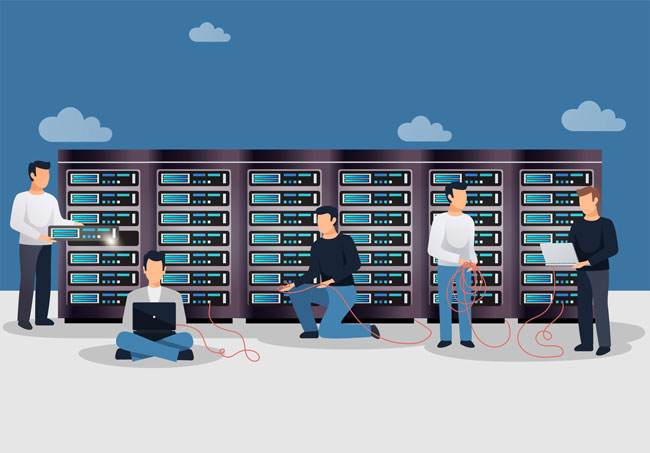
Enterprise Routing and Switching Specialist (JNCIS-ENT)
(JNCIS-ENT) - Training & Institute in Mumbai, India
JNCIS-ENT training is available at Octa Networks India, Mumbai which is one of the most agile training institutes. Octa Networks provides the JNCIS-ENT course in Mumbai Centre using Juniper devices (Routers, switches, etc.) in JNCIS-ENT lab Facility which is available 24x7. JNCIS-ENT syllabus is designed to validate skill sets related to Juniper technology in the Juniper Networks Certification Program. Octa Networks ranked #1 for Enterprise Routing and Switching Specialist (JNCIS-ENT) Institute and Classes in India, Mumbai.
This is a specialist level certification for the students and professionals who are looking for enhancing their credentials with a global certificate which will open the doors of infinite possibilities in their careers in the routing and switching implementations in Junos.
JNCIS-ENT Certification Training at Octa Networks: KEY FEATURES
- Guaranteed training and access @ real-time Devices.
- Explanation of Juniper Enterprise Routing and Switching Concepts (theoretically &practically) on actual hardware Devices.
- 24*7 Access to JNCIS-ENTLab for students
- 60+ hours of training in the classroom with interactive whiteboard and projector.
- Candidates can attend repeat classes till they get their doubts cleared.
- Classrooms equipped with projectors, Wi-Fi connectivity, and Digital Pads.
- Pre-Certification and Post-Certification Support and Guidance
- Convenient availability of batches from early morning to late night.
- 24×7 access to Trainers / Mentors.
- Highly experienced, motivated, passionate and certified trainers
Target Audience:
- Diploma, BA, BCOM, BSC, BE or BCA Graduates
- Students and professionals in the IT and Technologies sector who wish to enhance their knowledge in the Data Center and enterprise routing and switching technologies and acquire an internationally recognized professional certification which can improve their job prospects.
Prerequisite:
Before taking the JNCIS-ENT course, candidates should be familiar with
- JNCIS-JUNOS
- Understanding of server system design and architecture
- Familiarity with Ethernet and TCP/IP networking
- Familiarity with SANs
- Familiarity with Fibre Channel protocol
- Understanding of JUNOS Enterprise Data Center Architecture
- Familiarity with hypervisor technologies (such as VMware)
- Data center networking concepts & storage concepts
- Data center virtualization
- Identify the concepts, operation, or functionality of Layer 2 switching for the Junos OS
- Bridging components
- Frame processing
- Describe the concepts, benefits, or functionality of VLANs
- Ports
- Tagging
- Native VLANs and voice VLANs
- Inter-VLAN routing
- Demonstrate knowledge how to configure, monitor or troubleshoot Layer 2 switching or VLANs
- Interfaces and ports
- VLANs
- Junos Network Director
- Inter-VLAN Routing
- Describe the concepts, benefits, operation, or functionality of the Spanning Tree Protocol
- STP and RSTP concepts
- Port roles and states
- BPDUs
- Convergence and reconvergence
- Demonstrate knowledge how to configure, monitor, or troubleshoot STP and RSTP
- STP
- RSTP
- Identify the concepts, benefits or operation of various Layer 2 protection or security features
- BPDU, loop or root protection
- Port security, including MAC limiting, DHCP snooping, Dynamic ARP inspection (DAI) or IP source guard
- MACsec
- Storm control
- Identify the concepts, benefits or operation of Layer 2 firewall filters
- Filter types
- Processing order
- Match criteria and actions
- Demonstrate knowledge how to configure, monitor, or troubleshoot Layer 2 security
- Protection
- Port security
- Storm control
- Firewall filter configuration and application
- Identify the concepts, operation or functionality of various protocol-independent routing components
- Static, aggregate, and generated routes
- Martian addresses
- Routing instances, including RIB groups
- Load balancing
- Filter-based forwarding
- Demonstrate knowledge how to configure, monitor, or troubleshoot various protocol-independent routing components
- Static, aggregate, and generated routes
- Load balancing
- Filter-based forwarding
- Describe the concepts, operation or functionality of OSPF
- Link-state database
- OSPF packet types
- Router ID
- Adjacencies and neighbors
- Designated router (DR) and backup designated router (BDR)
- OSPF area and router types
- Realms
- LSA packet types
- Demonstrate knowledge how to configure, monitor or troubleshoot OSPF
- Areas, interfaces and neighbors
- Additional basic options
- Routing policy application
- Troubleshooting tools (e.g., ping, traceroute,trace options, show commands, logging)
- Describe the concepts, operation or functionality of IS-IS
- Link-state database
- IS-IS PDUs
- TLVs
- Adjacencies and neighbors
- Levels and areas
- Designated intermediate system (DIS)
- Metrics
- Demonstrate knowledge of how to configure, monitor or troubleshoot IS-IS
- Levels, interfaces and adjacencies
- Additional basic options
- Routing policy application
- Troubleshooting tools (e.g., ping, traceroute, trace options, show commands, logging)
- Describe the concepts, operation or functionality of BGP
- BGP basic operation
- BGP message types
- Attributes
- Route/path selection process
- IBGP and EBGP functionality and interaction
- Demonstrate knowledge of how to configure, monitor, or troubleshoot BGP
- Groups and peers
- Additional basic options
- Routing policy application
- Troubleshooting tools (e.g., ping, traceroute,trace options, show commands, logging)
- Identify the concepts, requirements or functionality of IP tunneling
- Tunneling applications and considerations
- GRE/UDP
- IP-IP
- Demonstrate knowledge of how to configure, monitor or troubleshoot IP tunnels
- GRE/UDP
- IP-IP
- Troubleshooting tools (e.g., ping, traceroute, trace options, show commands, logging)
- Identify the concepts, benefits, applications or requirements for high availability in a Junos OS environment
- Link aggregation groups (LAG)
- Redundant trunk groups (RTG)
- Virtual Chassis
- Graceful restart (GR)
- Graceful Routing Engine switchover (GRES)
- Nonstop active routing (NSR)
- Nonstop bridging (NSB)
- Bidirectional Forwarding Detection (BFD)
- Virtual Router Redundancy Protocol (VRRP)
- Unified In-Service Software Upgrade (ISSU)
- Demonstrate knowledge of how to configure, monitor, or troubleshoot high availability components
- LAG and RTG
- Virtual Chassis
- GR, GRES, NSB, and NSR
- VRRP
- ISSU
- Troubleshooting tools (e.g., trace options, show commands, logging)
Exam
Exam
- Exam Code: JN0-348
- Written exam
- Administered by Pearson VUE
- Exam length: 90 minutes
- Exam type: 65 multiple-choice questions
- Pass/fail status is available immediately
- Software Release:
- Junos 18.4
- JNCISJunos Space Network Director 3.1
Training Plan & Schedule
Training Plan
| Weekend Batch: Sat - Sun | |||
| Duration | Timing | Mode | Course Fees |
| NA | NA | NA | NA |
| Weekday Batch: Mon - Fri | |||
| Duration | Timing | Mode | Course Fess |
| 4 weeks | 2 Hours / Day | Online/Onsite | Ask For Quote |
Group Discount
In a Group of 2 discount will be 10% per head
In a Group of 3 discount will be 15% per head
In a Group of 4 discount will be 20% per head


Frequently Asked Question
Octa Networks has JNCIS-ENT batches scheduled as per the convenience of the certification aspirants. Regular (Mon-Fri) classroom training takes 4 weeks or 40 hours.
Yes. JNCIS-ENT certification isthe qualifying criteria for professional certification for Data Center and Enterprise Routing & Switching certification tracks.
JNCIS-ENTis valid for three years.
The JNCIS-ENT Certification is the gateway for getting hired by global companies. Successful completion of prestigious JNCIS-ENT Training and Certification enhances your job profile along with disseminating practical and applicable knowledge and skill-sets related to Juniper Data Center and enterprise routing & switchingtechnology and products.
The prime objective of the JNCIS-ENT training is to develop skilled professionals who can understand, configure and troubleshoot the Juniperenterprise routing and switching and data center solutions across the globe. The respect and demand of JNCIS-ENT certified professionals are matchless. The average salary ranges from 3,00,000 – 4,00,000 INR.
JNCIS-ENTcertificate examination duration is 90 minutes. Examination consists of 65 multiple choice questions.






